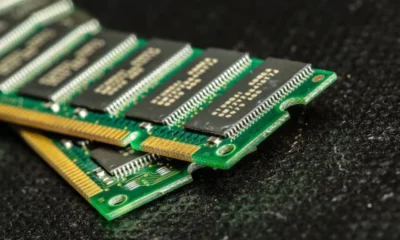TECHNOLOGY
Ankwave: The Future of Connectivity for Smart Devices and Beyond

Ankwave represents a revolutionary step forward in connectivity, addressing the limitations of traditional technologies like Wi-Fi and Bluetooth. It delivers faster, more reliable communication between devices while consuming minimal energy, making it an ideal solution for modern environments. Its design ensures seamless integration with existing networks, providing long-range and high-speed connections essential for connected ecosystems such as smart homes and offices. Beyond convenience, Ankwave is poised to transform industries including telecommunications, IoT, and healthcare. By combining efficiency with sustainability, it supports critical sectors and aligns with global eco-friendly initiatives. Ankwave is not just a tool; it’s a leap toward the future.
How Does Ankwave Work?
Ankwave uses wireless technology to deliver data in as efficient a manner as possible over a broad area. While ordinary Wi-Fi may slow down in population-dense areas or Bluetooth is restricted to a short range of connections, it provides the ideal connection speed and distance. in this way, it ensures that devices stay connected longer, without consuming much power.» Real-time operation is possible because of low latency – a feature worthwhile for the healthcare sector and self-driving cars. The data’s extensive application it has incorporated innovative algorithms and superior hardware to reduce the extent of loss of packets thereby supporting its communication in the shakiest of networks.

Core Features of Ankwave
- Long-Range Connectivity: Enables seamless communication over extended distances without signal degradation.
- High-Speed Data Transfer: Supports real-time data exchange crucial for demanding applications.
- Energy Efficiency: Minimizes power consumption, ensuring devices stay operational longer.
- Low Latency: Reduces delays, making it ideal for time-sensitive applications like telemedicine.
- Versatile Integration: Works seamlessly alongside existing technologies like Wi-Fi, Bluetooth, and 5G.
Applications of Ankwave Across Industries
Ankwave in Smart Homes and Offices
In smart homes, Ankwave powers connected devices such as lights, thermostats, and security cameras. Its long-range connectivity ensures that devices across the home communicate efficiently. For offices, it enhances productivity by supporting high-speed networks that handle large volumes of data. Employees benefit from uninterrupted video conferencing, fast file sharing, and real-time collaboration. Unlike traditional networks, which may falter under heavy use, Ankwave’s efficiency ensures seamless operations. By reducing energy consumption, it also contributes to cost savings, making it an appealing choice for businesses aiming to reduce overhead expenses while enhancing their digital infrastructure.

Telecommunications and IoT Integration
It enhances IoT networks by offering a solid foundation for connected devices in order to deliver connected things. The new generation of home appliances, wearables, and industrial sensors can operate only at their best due to the high speed and reliability of the connections. Telecommunications providers can incorporate Ankwave to provide better services to the client and uphold new prospects in technologies such as augmented reality (AR) and virtual reality (VR). Together with 5G, it makes the world of billions of devices intelligible and makes them communicate effectively. This symbiosis ensures that companies and industries, including smart factories, connected retail, and other areas can advance more quickly at an IoT device level and ensures that IoT devices can work without delays or stoppages.
Healthcare and Telemedicine
The healthcare industry relies on reliable, high-speed connectivity for critical operations like telemedicine and remote monitoring. Ankwave ensures that patient data is transmitted securely and without delays, enabling doctors to make informed decisions in real time. It supports advanced applications such as robotic surgeries, where precision and low latency are paramount. Wearable health devices also benefit from Ankwave’s energy efficiency, lasting longer between charges. By empowering healthcare providers with cutting-edge connectivity, Ankwave not only saves lives but also improves the overall quality of care delivered, bridging the gap between patients and medical professionals.
Comparative Analysis
Ankwave vs. Traditional Connectivity Solutions
- Performance Metrics: Offers superior range, speed, and energy efficiency compared to Wi-Fi and Bluetooth.
- Scalability: Handles more devices simultaneously, crucial for environments with high device density.
- Reliability: Maintains stable connections even in signal-challenged environments.
Integration with Existing Networks
- Compatibility: Works alongside existing technologies, ensuring smooth transitions.
- Adoption Strategy: Simple implementation process with minimal disruption to current systems.
Sustainability and Eco-Friendliness
Ankwave’s energy-efficient design aligns with global sustainability goals by reducing the power consumption of connected devices. Unlike traditional networks that often require frequent recharging of devices, Ankwave extends battery life, contributing to less electronic waste. Its low power usage also translates to reduced carbon emissions, making it an eco-friendly choice for businesses and individuals alike. By prioritizing energy efficiency without sacrificing performance, Ankwave offers a solution that supports environmental conservation. In a world increasingly focused on sustainable practices, Ankwave emerges as a technology that combines innovation with responsibility.
Future Potential and Innovations
Ankwave’s journey is only beginning, with several developments on the horizon. Researchers are exploring ways to enhance its security features, ensuring data integrity in sensitive applications like healthcare and defense. Integration with artificial intelligence (AI) could optimize Ankwave’s performance, dynamically adjusting to changing network demands. Future iterations may include enhanced compatibility with emerging technologies like quantum computing and blockchain. As industries continue to adopt connected solutions, Ankwave is positioned to be a cornerstone of the global connectivity ecosystem. Its potential to transform not just communication but entire industries is boundless.
Conclusion
Ankwave is much more than a connectivity solution; it’s a look at the future of communications. This way, it overcomes the shortcomings of previous generations of technologies, offering unmatched rates, dependability, and power efficiency in device interaction. In the current world, it is used in homes, workspace, and even in specialized sectors such as health, and defense amongst others. To this end, as the world transitions to becoming sustainable Ankwave design plays a significant role of supporting environmental causes. As a versatile system capable of rewriting the rulebook on connectivity across sectors, Ankwave is well-placed to rewrite the book on technology interactions.
-

 BIOGRAPHY6 months ago
BIOGRAPHY6 months agoBehind the Scenes with Sandra Orlow: An Exclusive Interview
-

 HOME12 months ago
HOME12 months agoDiscovering Insights: A Deep Dive into the //vital-mag.net blog
-

 HOME1 year ago
HOME1 year agoSifangds in Action: Real-Life Applications and Success Stories
-

 BIOGRAPHY1 year ago
BIOGRAPHY1 year agoThe Woman Behind the Comedian: Meet Andrew Santino Wife




























